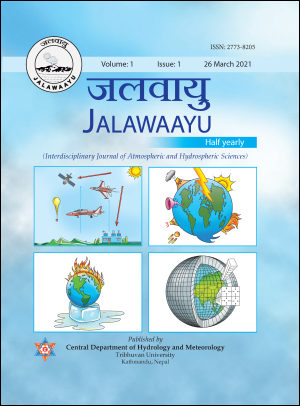Elevation Dependency of Precipitation over Southern Slope of Central Himalaya
DOI:
https://doi.org/10.3126/jalawaayu.v1i1.36446Keywords:
MSWEP, Precipitation, Elevation dependency, NepalAbstract
Precipitation plays vital roles in the global water cycle, knowledge of the spatial and temporal variation of the precipitation is essential to understanding extreme environmental phenomena such as floods, landslides, and drought. In this paper, the integrated characteristics of precipitation during 1980–2016 over Nepal along with the seasonal elevation dependency of precipitation were examined for three different regions over the country using Multi-Source Weighted-Ensemble Precipitation (MSWEP) product. The spatial distribution of mean annual precipitation varies significantly with the highest (lowest) precipitation of ~5500 (~100) mm/year in the Arun valley (Manang and Mustang). The precipitation regime of the country is determined by the contribution of the monthly precipitation amount with distinct spatial gradients between the eastern and the western sides during pre-monsoon, post-monsoon, and winter seasons. On the contrary, the spatial distribution of monsoon precipitation tends to more heterogeneous with visible differences between the lowland, midland, and highlands as similar to the annual one. Further, elevation dependency of seasonal precipitation revealed that the winter and post-monsoon precipitation distribution in western and central are very similar, whereas post-monsoon precipitation was found slightly higher than winter season in the eastern region. The highest precipitation areas in eastern and central region are located between 2000-2500 m, which is between 500 and 1000 m in the western region of the country. Overall, the pre-monsoon, summer monsoon and annual precipitation increases gradually with elevation upto 2500 m and then decreases with increasing elevation, whereas winter and post-monsoon precipitation are almost identical to each elevation interval of 500 m.
Downloads
Downloads
Published
How to Cite
Issue
Section
License
Copyright © of the articles is held by the authors.

